
The Taj Mahal is, without doubt, one of the most talked about, photographed, and written about monuments in the world. From academic critiques on its symbolism or its architecture, to essays on love using the Taj Mahal as a metaphor, to haiku poetry, you have it all.
For Indians, the Taj is a national treasure beyond any other, and for many international tourists the Taj Mahal is India and vice versa. The Taj has inspired countless brands from hotels to tea to inner-wear to tiles to… just about everything. Its enduring legend and its status as one of the 7 modern wonders of the world has ensured that everybody has an opinion on the Taj Mahal, whether they have seen it once, twice, many times, or not at all. 🙂
I was in Agra last month and the Taj, not surprisingly, was on my list of sights to see. Though I had never seen the Taj Mahal before, I had an image of what it would be like, and even what it should be like. My mental image of the Taj was also influenced by a lot of unsolicited comments and advice from friends and family members, who had seen the Taj and were keen to share their two bits with me. A sample:
“Taj Mahal is so beautiful and romantic. You’ll love it”
“What? You stay in India and you haven’t seen the Taj? Are you sure you are an Indian?
“Look, Sudha. See the Taj with an open mind. Just empty your mind of all emotions and prejudices of what you think it should be like when you go there. Otherwise, you’ll hate it.
“I didn’t like the place at all. It is over-rated and thanks to excellent marketing it has become what it is today.”
 I recall all this as I stand in a queue with countless others waiting to enter this modern “wonder of the world”. Though I tell myself that I should regard this visit to the Taj with an open mind, it is difficult not to be affected by my own prejudices plus the influence of all that I have read about or heard about the Taj.
I recall all this as I stand in a queue with countless others waiting to enter this modern “wonder of the world”. Though I tell myself that I should regard this visit to the Taj with an open mind, it is difficult not to be affected by my own prejudices plus the influence of all that I have read about or heard about the Taj.

It is only 6.00 am and from the buzz generated by the gathered national and international tourists, it seems like most are seeing the Taj for the first time. Cameras are getting readied for that first shot, text messages are being sent about the tryst with THE Taj Mahal, guides are giving their opening lectures, and the security guards are cracking their knuckles in anticipation for the rush.
And I? I am gearing myself up to see a monument, a sight, which is on probably on everyone’s list of things to do before they die. 😀 And then at around 6.15, when the sun starts peeking out from behind the trees, the gates are opened and the visitors are let in, and I get my first, full glimpse of the Taj Mahal.
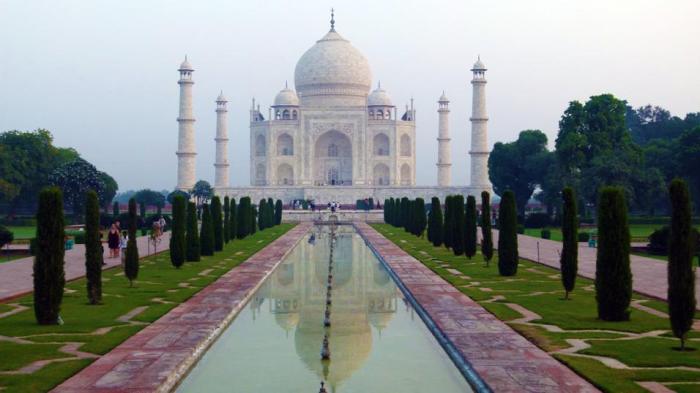
Before I say what I felt about the Taj Mahal after I really saw it, let me take you on a Taj tour as seen by me and recorded by my camera. 🙂
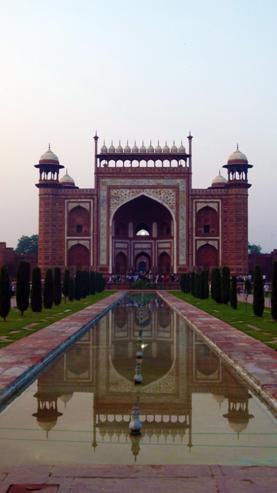

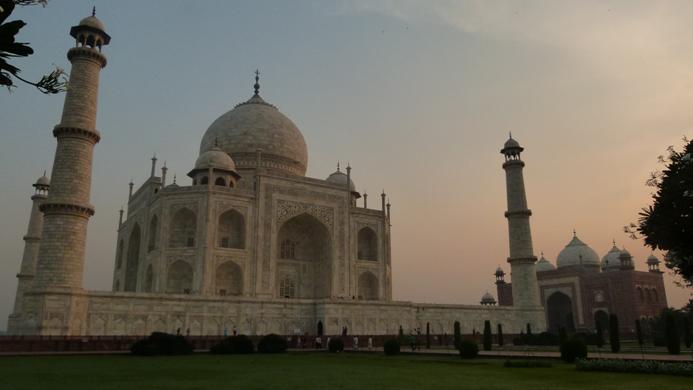


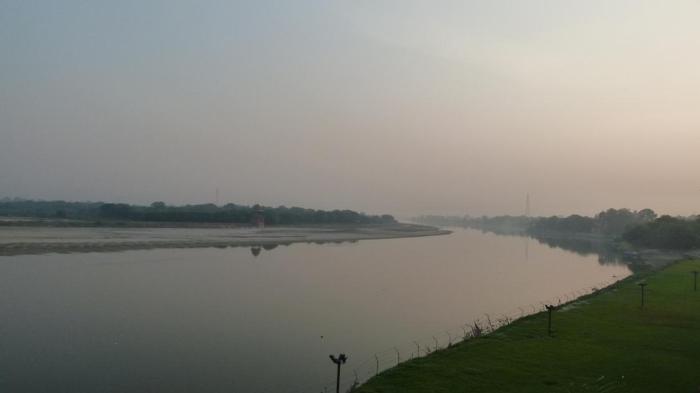
My first reaction of the Taj Mahal was “It’s so small, but oh-so perfectly symmetrical.” While the opinion of a “small” Taj changed during the course of my visit, the “symmetrical” part didn’t. Also, what got added to my list of adjectives for the Taj was its perfection in many aspects—symmetry, understated elegance, architecture… Though the Taj was conceived by the Mughal Emperor Shah Jahan as a mausoleum for his favourite wife, Mumtaz, it took 20,000 people 22 years to actually create the Taj Mahal as we see it.
The master builders came from different parts; the chief masons from Baghdad, Delhi and Multan; the dome builders from Asiatic Turkey and from Samarkand; mosaic workers from Kanauj and from Baghdad; the principal calligraphist from Shiraz. Every part of India and Central Asia contributed the materials; Jaipur, the marble; Fathepur Sikri, the red sandstone; the Panjab, jasper; China, the jade and crystal; Tibet, the turquoises; Ceylon, the lapis lazuli and sapphires; Arabia, coral and cornelian; Panna in Bundelkhand, diamonds; Persia, onyx and amethyst… Besides the lavish expenditure to the building, lakhs of rupees were spent in providing the richest of Persian silk carpets, golden lamps, and magnificent candlesticks.
 The above passage (p.74–75) in E.B. Havell’s book titled Handbook to Agra and the Taj (1904) gives an insight into the kind of planning that went into creating one man’s vision. It also explains why the Taj Mahal is the way it is. Nothing but the best would do for Shah Jahan. The brilliance of the structure, the bejewelled inlay work and the carvings on the walls, the restrained calligraphy… are absolutely fantastic. Photography is not allowed inside the central chamber of the Taj Mahal and that meant that I could also not photograph some of the best work. The surrounding 8 chambers, however, permitted photography and a photograph taken in one of the chambers is given below.
The above passage (p.74–75) in E.B. Havell’s book titled Handbook to Agra and the Taj (1904) gives an insight into the kind of planning that went into creating one man’s vision. It also explains why the Taj Mahal is the way it is. Nothing but the best would do for Shah Jahan. The brilliance of the structure, the bejewelled inlay work and the carvings on the walls, the restrained calligraphy… are absolutely fantastic. Photography is not allowed inside the central chamber of the Taj Mahal and that meant that I could also not photograph some of the best work. The surrounding 8 chambers, however, permitted photography and a photograph taken in one of the chambers is given below.
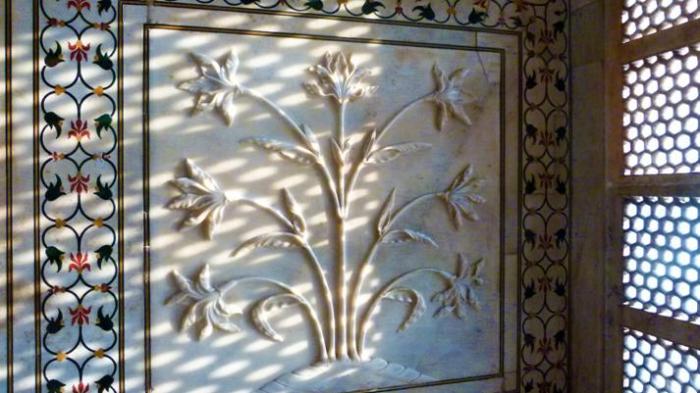
The Taj Mahal is perfectly symmetrical, no matter from which angle you look at it. But the symmetry is not restricted to the Taj alone as whatever other constructions have been carried out in the complex were keeping in mind both symmetry and balance. For instance, two identical, red sandstone structures have been built on either side of the Taj. One of them is a mosque that is used even today; the other is a jamaat khana or a meeting place for people, which was built just to balance out the mosque and maintain symmetry !
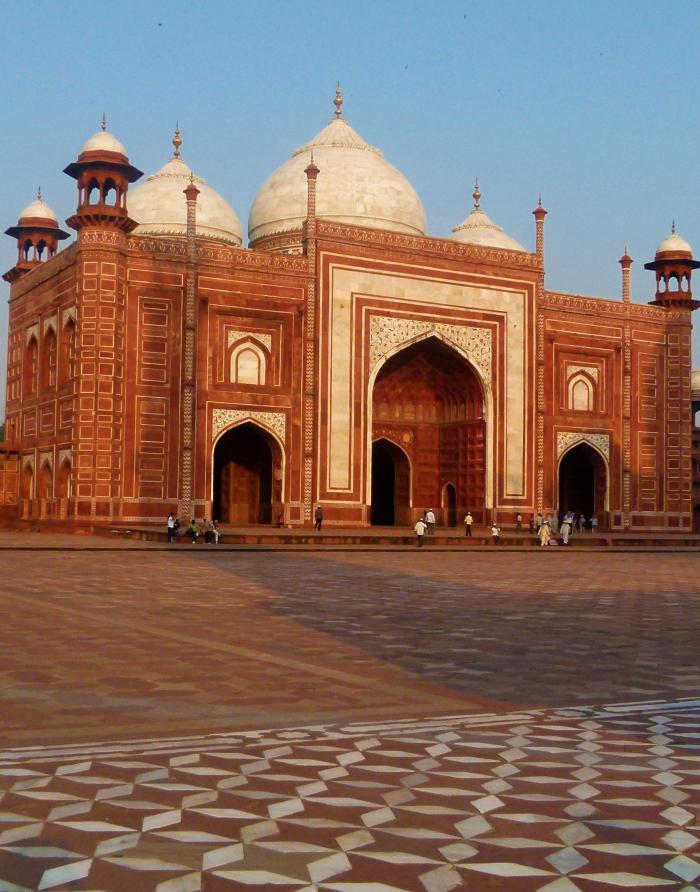
My first impression of the Taj was not a very favourable one, and to be honest I found it over-rated. Besides, marble, the building stone used for the Taj Mahal, is not my favourite building stone. All this meant that I was already prepared to dislike the Taj. But then slowly, the impression changed during the course of the visit and then over the days as I recalled details and impressions of my visit there. It is only when I felt that I could write a more balanced post did I begin to write this one.
But I didn’t want this post to be a rant on the differential rates charged for Indians (Rs.20) and foreigners (Rs.750) or about how dirty the place was with wafer packets and empty mineral water bottles littered about. I didn’t even want it to be a post about how the Taj Mahal attendants (if one can call them that) ask money from tourists to shine a torch on the inlay work to demonstrate the luminescent quality of the gemstones used there, or the unruly crowds. I didn’t want it to be a post on my perception of Taj as a symbol of eternal love, or its justification in being included as one of the wonders of the world.
I simply wanted it to be about the Taj Mahal. The Taj as I saw it and its grandeur, which is understated from a distance, but gets overwhelming when you are close-up. The few photographs are just a glimpse of what the Taj Mahal is and is, by no means, comprehensive. To be honest, no photograph of the Taj can do justice to it. The only way one can do justice to the Taj is to visit it again and then, maybe again. For how else can one see this grand edifice of symmetry, perfection.
Have you visited the Taj? If yes, what is your opinion? If no, what is your opinion about the Taj? I would love to hear from you on this topic 🙂
♦ ♦ ♦ ♦ ♦ ♦ ♦
Read more about other places to visit in Agra:

Magical… isn’t it?
LikeLike
Absolutely. Though the magical feeling crept in very slowly and very unobstrusively.
LikeLike
I dont know if it is the properties of the marble but it is soooooooooo damn peaceful… I totally love this monument.. but somehow die hard romantic that I am still I have never been able to connect it with Love.. no seriously i dont know why but it fails to bring in that feeling..
LikeLike
Maybe it is. The guide was telling me that the Taj was an experiment in Mughal architecture where they moved away from the predominantly red structures that they had built to this. White denotes peace and is soothing, So maybe that is why you feel peaceful. As for your not being able to connect with it on the plane of love, is it because the Taj is after all a mausoleum?
LikeLike
Thanks for your post on the Taj Mahal. It is a place I would love to visit one day. To me, it looks magical and the amount of labour that went into the construction – I have to see it to believe it. I recently wrote a post on the Sagrada Familia in Spain and your post echoed many of the thoughts I had about it. Most notably, that no amount of photographs can do the church justice. You really have to be present with the building to feel its significance. Great post!
LikeLike
Welcome here, Marina, and thank you so much for stopping by and commenting. The Taj is a magical place, but one that reveals itself slowly, ever so slowly. I do hope that you get to visit India one day and see the Taj and other places too. For no matter what people may say, the Taj may be a symbol of India, But India is just not the Taj 🙂
LikeLike
I was a kid when i visited the Taj… about 8 or 9… samhith’s age…and i still remember it vividly.. not the mosque, not the entrance,,, nothing else, except the Taj, and the fact that i almost got run over by a truck as i rushed to cross the road!!! i was too young to know about the details, but the beauty has remained in my memory… also it wasnt as commercialised then… it hadnt got the world heritage status then…. and i am rather surprised to read about the wafer packets etc, because even in those days, they constantly kept cleaning the whole area….i seem to remember thinking that they kept cleaning the taj while the yamuna was so dirty… there was barely any water, it looked like a gutter and my mom kept remembering about the time she came there as a child and the water was flowing almost up to the Taj!!!! its interesting to see what we remember of a place after almost 30 years!!!
LikeLike
Those are really vivid memories, Anu ! I guess, once they see the Taj, they don’t remember anything else 🙂 I had gone early in the morning when the cleaning crew had not been in and the trash from the previous day had still not been cleared out. Apparently, they come in at 11.00. But my point is, if the security guards can be in place, the guides can be in place, the Taj attendants can be in place, why can’t the cleaning crew also be in place?
LikeLike
Wonderful piece Sudha.
I agree with most of your reflections. The last time I visited the Taj, it took me a long time to forget the filth of the city and not scowl about the differential ticket prices. I couldn’t concentrate because of the crowd and the noise and the guides…they didn’t seem to be adding anything new to anyone’s knowledge but surely contributed to the buzz. But, after a while, as the Taj began to sink in and when I stood by the Yamuna and gazed at the other side, I was blown. The Taj is a beautiful monument indeed. I hope the city that houses it could be better maintained.
LikeLike
I think we could be ‘scowl sisters’ because I also do that a lot 😀 The Taj is symptomatic of a disease that afflicts Indian officialdome, nay Indians itself. We concentrate of localised solutions or treatment to take care of a larger malaise and the Taj is a good example of that. I’m sure that the Babus feel that as long as the Taj is accessible to tourists, who will care about what the city is like?
LikeLike
Nice pictures 🙂 🙂 Symbol of love !
http://deepakkarthikspeaks.blogspot.com/
LikeLike
Thanks, Deepak. Symbol of love or symmetry, it is a magical place. 🙂
LikeLike
nice review ! just love it !
LikeLike
Thank you, Mandar. I’m glad that you liked it.
LikeLike
wonderfully objective 🙂
LikeLike
Thank you, Magiceye. If I had written this piece even 3-4 days back, it would have been quite different. 🙂
LikeLike
I have never been to Taj Mahal. I will surely visit one day.
Beautiful pictures!
It seems magical to me too. Guess, I have been living vicariously through other’s experiences.
LikeLike
Yes, Megha. The Taj IS a magical experience and I feel that each one feels it differently. And you must experience the Taj with your own eyes and other senses and not vicariously through others. 🙂
LikeLike
I felt a sense of deja vu when I visited it first 22 years ago but on subsequent visits as I had to escort several foreign guests to the place, it grew over me and I began appreciating the intricate inlay work and the architectural marvels like the whispering corner. But always, but always I felt ashamed of the filth and litter of the place and hoped desperately that they were not noticed by my guests who were overawed by the main structure 😦
I loved the way you have included all that you didn’t like about the Taj 🙂
LikeLike
Deja vu ! That is the word I was looking for and that’s exactly what I too felt when I saw the Taj for the first time. And like you, it kind of grew on me, even though I fought the feeling 😀
As for the filth and litter, lets not talk about it, shall we?
LikeLike
I visited TAJ during the emergency 1977, well it was magnificent monument, maybe i remember distinctly visiting during the full moonlight too. The crowd was not much, we didn t have a camera, could not capture the pics than, got to visit once again and trace some of the antecedents. Can you believe it was once up for a auction for its scrap value during the British regime…
LikeLike
It was up for auction? I didn’t know this fact about the Taj. I wanted to see the Taj during on a moonlight night, but I had a packed schedule and couldn’t manage it.
LikeLike
I ve never seen the Taj at dawn.. Thanks for sharing…
LikeLike
And I have seen it only at dawn, lit up by the morning light and changing colour from light delicate pink to a mellow golden. It was absolutely gorgeous 🙂
LikeLike
Sadly…my first impression was also the same as you. I was and still am unimpressed by this modern wonder of the world. But I guess the time of visit, the atmosphere and most importantly, the company one has while visiting affects one’s perspective n views drastically.
I guess I’ve to visit Taj once again to see if my perseption changes.. 🙂
Care to join Sudha?
LikeLike
The Taj is one monument that you can never expect to be empty. I am also not too fond of crowded documents but had made peace about this reality before I went to visit it. But your point about the company one has while visiting the Taj is an important one. I was alone and I had all the time in the world to dislike it on sight and then also change my opinion during the course of my visit without anyone telling me that I told you so. 🙂
Now that I have seen it, I wouldn’t mind some company, and would love to join you.
LikeLike
I have been to the Taj Mahal just once, and i think its the first glimpse from that entrance that blows one away. The whiteness, the picture perfect structure with its minarets and those Mughal domes – so perfect and so pleasing to the eyes really! I liked the idea of entering early morning. I would love to visit again and see it at dawn if entry is allowed!
LikeLike
The Taj is open from sunrise to sunset and if you buy your tickets the previous day you can be inside the monument when it opens at sunrise and watch it change colours–from a pale white, to a delicate pink and then a mellow golden yellow. 😀
LikeLike
have never been to Taj Mahal..but it sure grabs a space on my to visit places , now that i chanced upon ur post . . beautifully weaved 🙂
LikeLike
Then you must go to the Taj Mahal. you wouldn’t be an Indian otherwise 😛
Welcome here, Maliny and thank you so much for stopping by and commenting. And I hope that you will keep visiting
LikeLike
Wow so nice & interested post good pic sharing. thanks for sharing.
LikeLike
Your photos along with your lovely descriptions took me to a whole new world 😀
PS, I absolutely love your display picture on wordpress 😀
I thank you for this lovely post, I went to Taj Mahal!!! 🙂
Ma’am, if you had a few minutes to spare, could you read a post of mine? And maybe leave a feedback and a vote if you like it? I’d be really really grateful, it’d go a long way in helping me with a competition on indiblooger 🙂
http://www.indiblogger.in/indipost.php?post=90039
LikeLike
Welcome here, Achyuth, and thank you so much for stopping by and commenting. The Taj is really something, isn’t it ? 🙂
LikeLike